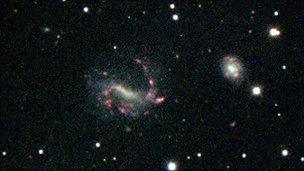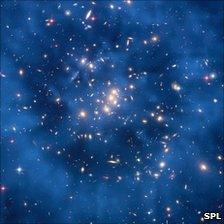Dark matter theory challenged by gassy galaxies result
- Published

"Low surface brightness" galaxies like F549-1 lend greater precision to the Mond theory's predictions
A controversial theory that challenges the existence of dark matter has been buoyed by studies of gas-rich galaxies.
Instead of invoking dark matter, the Modified Newtonian Dynamics theory says that the effects of gravity change in places where its pull is very low.
The new paper suggests that Mond better predicts the relationship between gassy galaxies' rotation speeds and masses.
However, critics maintain that dark matter theory is a better general description of the Universe we see.
The study, available online, external, will be published in Physical Review Letters.
The theory that first proposed dark matter was developed in large part to account for mass that, if everything else we think about gravity is correct, seemed to be missing in rotating galaxies.
Standard formulations of gravity have it that matter circling, for instance, spiral galaxies, should rotate more slowly with increasing distance from the centre of the galaxy - much as the outer planets in our Solar System orbit more slowly than their innermost counterparts.
But the matter in rotating galaxies seems consistently to rotate with roughly equal speed near their cores and at their edges.
In the standard dark matter theory, cosmologists proposed a massive yet invisible quantity of material in order to solve this "flat rotation curve" problem.
This dark matter is imagined to exist in a "halo" around galaxies, providing the extra gravitational pull necessary to speed up those outlying bodies.
By contrast, Modified Newtonian Dynamics (Mond) first appeared in 1983, when Mordehai Milgrom of the Weizmann Institute in Israel proposed it in an Astrophysical Journal paper, external.
As a modification to the dearly-held formulation of gravity laid out by Isaac Newton, the theory came immediately under fire. It has always maintained a minority position among theories proposed to solve the missing mass problem.
Trompe le Mond
Now, Stacy McGaugh of the University of Maryland in the US says that a study of galaxies that have few stars and are dominated by gas adds weight to the Mond theory.
The current work hinges on what is known as the Tully-Fisher relation, which maps out the interplay between galaxies' mass and their speed of rotation.
However, mass estimation is a tricky business because it depends on the amount of light a galaxy emits, which varies considerably with the types and quantities of stars it contains.
To get around this error, Professor McGaugh studied 47 gas-rich galaxies with few stars, known as low surface-brightness galaxies.
He found that the Mond theory neatly predicts the relation between the galaxies' masses with their rotation speed - and contends that dark matter theory would do so far less accurately.
"My attitude toward low surface brightness galaxies at first was 'great, this will finally be able to falsify the Mond theory'," Professor McGaugh told BBC News, "but it was the only thing that explains this shift in the relation."
"Whenever I look at smallish things like individual galaxies it works really well."
However, he conceded that "when you get up to the big scale of clusters of galaxies and you try to apply Mond to the whole thing, you fall short of fixing the missing mass problem".

Lambda-CDM theory holds that dark matter "haloes" surround galaxies and clusters
Dan Hooper, a theoretical astrophysicist at Fermi National Accelerator Laboratory in the US, said that Professor McGaugh's formulation "overstates the case" in that it assumes all galaxies will have the same ratio of normal matter to dark matter.
"That's not what we'd expect," he told BBC News.
"Some galaxies have very little stars and gas material compared to dark matter, and we don't expect the biggest galaxies to have the same fraction - which would change the shape of that line (relating galactic mass to spin speed)."
"I don't think the Mond/dark matter debate hinges on the Tully-Fisher anymore," he added. "Mond only explains galaxies - everything else it fails to do or simply can't address."
Nevertheless, Mond still counts several prominent cosmologists among its adherents, and Professor McGaugh said his work continues to show that Mond is a serious contender that dark matter theory will have to work to disprove.
"Sometimes I wish I didn't work on this," Professor McGaugh said. "If your own data don't get in your face about this, it's easy to say 'so-and-so screwed up'."
He maintains that Mond represents a missing piece of the dark matter model that a majority of his peers hold to be a complete picture of the makeup of our Universe.
"At the very least, it's telling us something about dark matter that's not native to our current model."
- Published11 January 2011